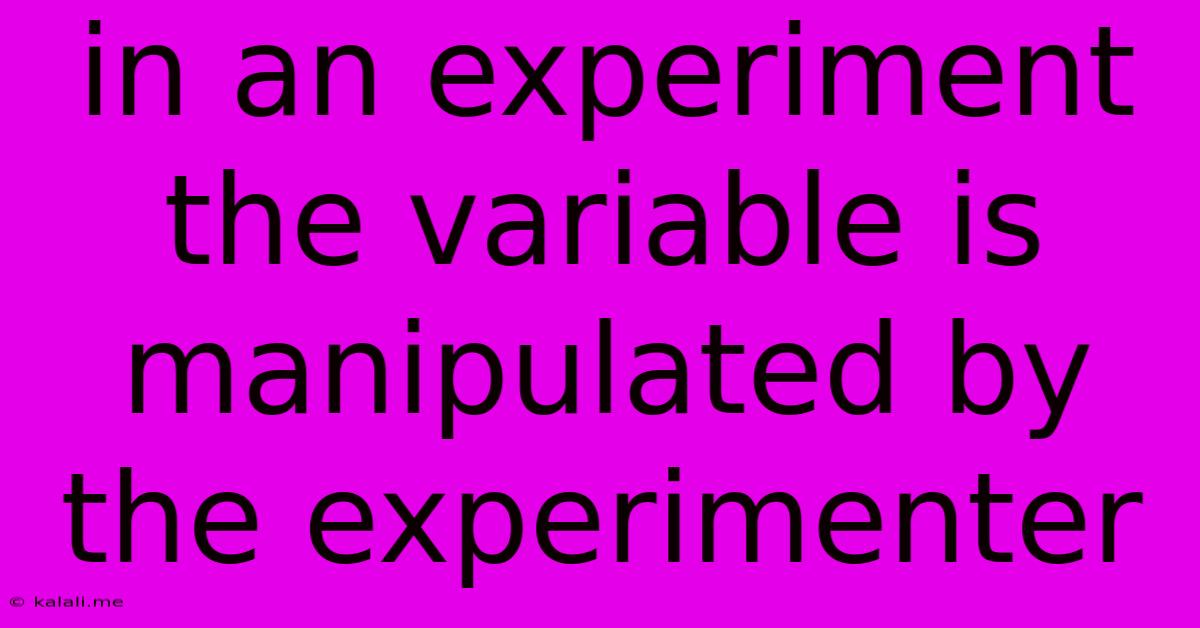In An Experiment The Variable Is Manipulated By The Experimenter
Kalali
May 09, 2025 · 3 min read

Table of Contents
Understanding Manipulated Variables in Experiments: A Deep Dive
Meta Description: Learn about manipulated variables in experiments. This comprehensive guide explains what they are, how they're used, and their crucial role in establishing cause-and-effect relationships. We explore examples and the differences between manipulated and controlled variables.
In the scientific world, experiments are the cornerstone of discovery. They allow us to test hypotheses and establish cause-and-effect relationships between variables. A key element of any well-designed experiment is the manipulated variable, also known as the independent variable. This is the variable that the experimenter deliberately changes or controls to observe its effect on another variable. Understanding manipulated variables is critical to understanding the scientific method and interpreting experimental results.
What is a Manipulated Variable (Independent Variable)?
A manipulated variable is the factor that researchers actively alter or change in an experiment. Its purpose is to see how this change affects another variable, the dependent variable. The experimenter directly manipulates the independent variable, carefully controlling its levels or conditions to observe the resulting changes. Think of it as the cause in a cause-and-effect relationship.
It's important to distinguish the manipulated variable from other variables within the experiment. While the experimenter manipulates the independent variable, they control other variables to maintain consistency and prevent confounding factors from influencing the results. These are known as controlled variables.
Examples of Manipulated Variables
Let's explore some examples to clarify the concept:
-
Testing the effect of fertilizer on plant growth: The manipulated variable is the amount of fertilizer applied to different plant groups. The dependent variable would be the plant growth, measured by height or biomass.
-
Investigating the impact of light exposure on sleep quality: Here, the manipulated variable is the duration of light exposure before bedtime (e.g., varying hours of screen time). The dependent variable is the sleep quality, assessed through sleep duration or sleep stages.
-
Studying the influence of temperature on reaction rates: The manipulated variable is the temperature at which a chemical reaction occurs. The dependent variable is the reaction rate, measured by the speed at which products are formed.
In each example, the experimenter directly controls the manipulated variable and observes its effect on the dependent variable, carefully controlling other potentially influential factors.
Controlled Variables: Maintaining Consistency
While manipulating the independent variable is crucial, it's equally important to control other variables that could potentially influence the outcome. These controlled variables are kept constant throughout the experiment. Ignoring controlled variables can lead to inaccurate results and flawed conclusions. For example, in the plant growth experiment, controlled variables could include the type of soil, amount of water, and the amount of sunlight each plant receives. Maintaining consistency in these variables ensures that any observed differences in plant growth are directly attributable to the varying levels of fertilizer.
Why are Manipulated Variables Essential?
The manipulation of the independent variable is essential for establishing causation. By systematically changing the independent variable and observing its effect on the dependent variable, researchers can determine if a causal relationship exists between the two. Without manipulating a variable, it's impossible to draw conclusions about cause and effect; any observed correlation might be due to other factors. This controlled manipulation is what differentiates a true experiment from observational studies.
Conclusion: The Foundation of Experimental Design
Understanding the role of the manipulated variable, or independent variable, is fundamental to designing effective and valid experiments. By carefully controlling and manipulating this variable, researchers can conduct experiments that yield meaningful results and contribute to scientific knowledge. Remember, the meticulous manipulation of the independent variable, alongside the control of other variables, is the cornerstone of establishing cause-and-effect relationships and advancing our understanding of the world around us.
Latest Posts
Latest Posts
-
What Percent Of 75 Is 90
May 09, 2025
-
What Is 2 To The 8 Power
May 09, 2025
-
What Percentage Of 18 Is 6
May 09, 2025
-
What Does The Arrow Represent In A Food Chain
May 09, 2025
-
How Do You Know A Chemical Reaction Has Taken Place
May 09, 2025
Related Post
Thank you for visiting our website which covers about In An Experiment The Variable Is Manipulated By The Experimenter . We hope the information provided has been useful to you. Feel free to contact us if you have any questions or need further assistance. See you next time and don't miss to bookmark.